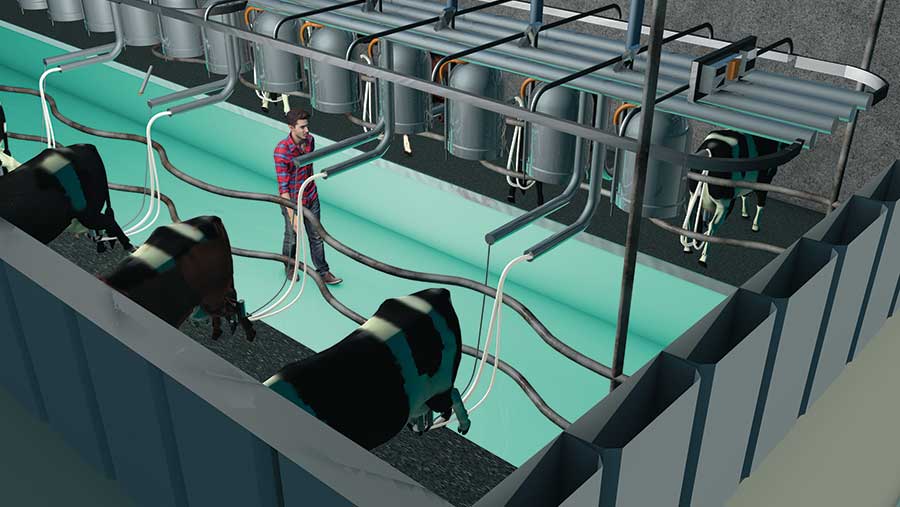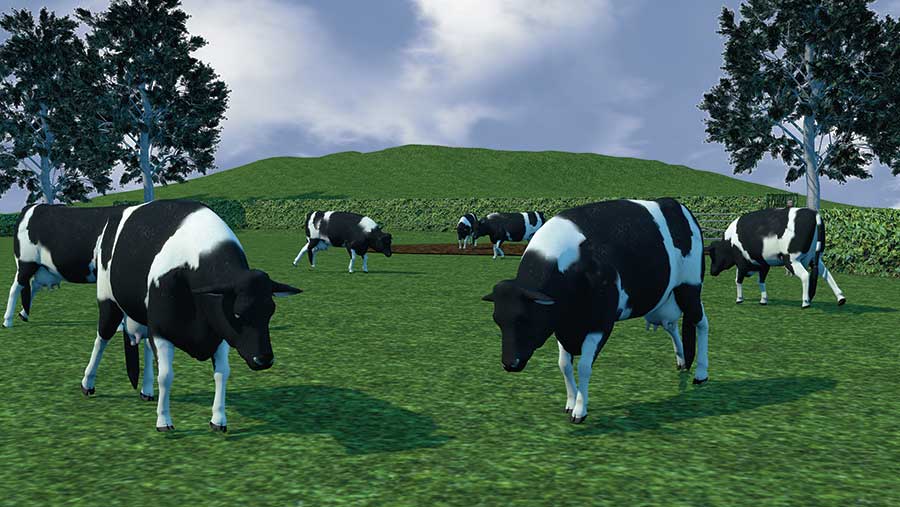Model dairy finds outlook better but cashflow a challenge
 © Tim Scrivener
© Tim Scrivener The 215-cow model dairy business was budgeted to make a £20,000 trading loss in the year to 31 March 2017, but in fact ended the year with a slightly smaller loss, at £15,739.
The outlook for the current year is much better and is budgeted to result in a profit of almost £72,000.
However, as on most dairy farms, there is a lot of ground to make up after the milk price drop of 2015-16 and cashflow management is tricky.
See also: Arable virtual farm shows better outlook for harvest 2017
The original plan to expand to 300 cows this year was thrown off course by the dairy downturn, with lack of cash forcing the decision last year to slow down the expansion by selling off 50 cows and breeding heifers.
This helped to limit the rise in the overdraft to £55,929, to close the year to 31 March 2017 at £70,940.
The improvement in the milk price early this year encouraged the family to resume its expansion plan, although at a much slower pace than originally intended, so that the herd had expanded by just 15 head to 215 cows by 31 March 2017.

© Paul Wootton
While the higher profit forecast is welcome, cashflow must be the priority.
There is a small improvement in the overdraft for the time being, but the budgeted year-end position (March 2108) of £54,000 is £35,000 higher than in April 2016.
Significantly, the peak overdraft is budgeted at £96,000, some £30,000 more than the previous year.
With a budgeted milk price of 28p/litre (7.5p/litre higher than the 2016-17 price), total milk output is budgeted to increase by 82,439 litres (5% on the year).
The rise is mainly due to the higher milk price, but the higher cow number accounts for £23,000 of the anticipated £150,000 milk output improvement.
Budgeted purchased feed cost this year is up by 1p/litre at 8.96p/litre, an increase of about 1p/litre on the previous year.
Forage costs will rise by £4,500, a 9% increase on the previous year accounted for mainly by the increased area and a larger spread of crops.
Cow and heifer numbers
Currently at 215 cows, the herd is budgeted to expand to 230 cows by March 2018 through the introduction of 85 heifers due to calve this milk year.
Seventy culls and casualties are budgeted to leave the herd this year, while 109 calves are planned to be retained from births this year and 130 potentially able to calve in the following year.
All of this would allow the herd to be at the target 300 head by 2019-20
This rebuilding of the herd and the consequent high youngstock numbers is the main reason for the overdraft remaining at the budgeted levels.
The increase in numbers gives rise to a valuation increase and therefore, while profit is rising, this is not reflected by greater cash generation, points out Charles Skelton, consultant and associate director with Savills food and farming team.
“We are seeing this on a lot of farms.
“Typically with any business trying to expand there is a requirement for additional working capital, so while there is an improvement in the overdraft position [because there is more cash coming in from higher milk prices], it is not much of an improvement.”
The business review carried out last year also highlighted areas where there is scope to improve technical performance and potentially increase herd output without increasing costs.
Forage efficiency and yield from forage
The business has set a target to reduce the purchased feed rate from the current budget and actual position of 0.34kg/litre to 0.32kg/litre by the end of the year.
This should deliver a reduction of 33t in purchased feed use, a saving of £7,000/year at current costs. The longer-term plan is to reduce the purchased feed rate to 0.30kg/litre.
Improving milk production from home-grown forage will be given high priority as the route to lower purchased feed use.
To this end, dry matter intake from home-produced forage has been identified as a weakness in the system.
This will be addressed by growing four different forages – grass, maize, wholecrop and lucerne.
This will improve digestibility and the protein mix, as well as raising home-grown protein levels. It should improve palatability too.
Silage clamp management will be tightened, first at silage-making, ensuring good consolidation and swift sealing to cut waste.
Silage feeding efficiency will be addressed by making sure the shear grab is sharp and makes a clean cut, again reducing waste and avoiding air spoilage.
Dry cow forage management is also targeted for improvement.
Vet fees
The family has reviewed other costs and identified vet costs as higher than in the best-performing businesses.
“At £80 a head it is not excessive, but we need to make sure we are getting the performance we should be getting for that spend,” says Mr Skelton. Top-25% herds on average spend about 0.8p/litre, while the model farm is spending almost 1p/litre on this area.
A review of the inputs, including routine visits and drug use, will be undertaken with the vet.
One of the areas to be considered will be whether the herd is not yielding at levels typically expected with the degree of input committed, therefore a review of cow performance will also be undertaken by benchmarking with comparable herds.

© Paul Wootton
Youngstock and heifer management
The number of youngstock could be reduced by better monitoring and closer targeting of heifer growth rates. These will be measured at six, nine and 12 months,to achieve the right weights for bulling at 15 months and to calve at 24 months rather than the current 26 months.
To assist with this, a Leader grant for improved handling facilities is being investigated. This falls within priority one (farm productivity) under Leader funding, which includes investments to improve overall performance and sustainability of an agricultural holding.
A fictional dairy farm, fully costed and based on dairy businesses advised by Savills. This allows scenarios to be modelled and their impact assessed.
- Family partnership of parents and son
- 180ha farm, mainly ring-fenced
- 160ha owned, 20ha on 10-year Farm Business Tenancy
- One full-time employee
- All Grade 3 medium/heavy soil type on undulating terrain
- Total long-term borrowings of £428,000, made up of a loan taken out several years ago to buy bare land adjoining the core farm (at £178,000), plus a more recent loan of £250,000 for investment in improvements to dairy facilities
- Rainfall 760mm, altitude 125 – 180m
- In a nitrate vulnerable zone
Savills model dairy farm – the dairy enterprise
- 215 cow, 8,100-litre high output system
- Year-round calving
- Performance in line with AHDB top 25%
- Investment in new parlour, bulk tank and additional cubicles in 2013-14
Model dairy farm budgets |
||||
|
|
Year ending March 2017 |
Year ending March 2018 |
||
|
|
Total (£) |
£/ha |
Total (£) |
£/ha |
|
Gross margin |
195,680 |
1,087 |
287,403 |
1,597 |
|
Other farm income |
35,700 |
198 |
35,700 |
198 |
|
Fixed costs |
||||
|
Labour |
43,000 |
239 |
43,215 |
240 |
|
Power |
138,090 |
767 |
136,248 |
757 |
|
Maintenance |
35,160 |
195 |
38,054 |
211 |
|
Miscellaneous |
7,400 |
41 |
10,400 |
58 |
|
Total fixed costs |
223,650 |
1,243 |
227,917 |
1,266 |
|
Profit before rent and finance |
7,730 |
43 |
95,186 |
529 |
|
Rent and finance |
23,469 |
130 |
24,260 |
133 |
|
Net profit |
-15,739 |
-87 |
70,926 |
396 |
Model dairy – full cost of milk production calculation |
|||||
|
|
Budget 2016-17 |
Budget 2017-18 |
AHDB 2015-16 |
||
|
Revenue |
£ |
p/litre |
£ |
p/litre |
Top 25% p/litre |
|
Milk |
346,450 |
20.50 |
496,283 |
28.00 |
|
|
All other income* |
174,850 |
10.35 |
102,100 |
5.76 |
|
|
Purchased feed |
135,135 |
8.00 |
158,745 |
8.96 |
9.2 |
|
Forage |
50,060 |
2.96 |
54,560 |
3.08 |
|
|
Other direct costs |
58,975 |
3.49 |
61,975 |
3.50 |
2.7 |
|
Total direct costs |
289,920 |
17.16 |
275,280 |
15.53 |
|
|
Labour |
43,000 |
2.54 |
43,215 |
2.44 |
2.4 |
|
Power & machinery |
101,750 |
6.02 |
103,927 |
5.86 |
3.7 |
|
Office & administration |
26,400 |
1.56 |
32,490 |
1.83 |
0.9 |
|
Rent & finance |
23,469 |
1.39 |
24,260 |
1.37 |
1.7 |
|
Total overheads |
194,619 |
11.52 |
203,892 |
11.50 |
|
|
Depreciation |
52,500 |
3.11 |
48,285 |
2.72 |
1.3 |
|
Drawings |
25,000 |
1.48 |
25,000 |
1.41 |
1.2 |
|
Total cost of production |
562,039 |
33.26 |
552,457 |
31.17 |
24.8 |
|
Full economic net margin |
– 40,739 |
-2.41 |
45,926 |
2.59 |
– 24.8 |
| *Includes income of £45,750 in 2016-17 from sale of stock to generate cash because of dairy downturn | |||||
